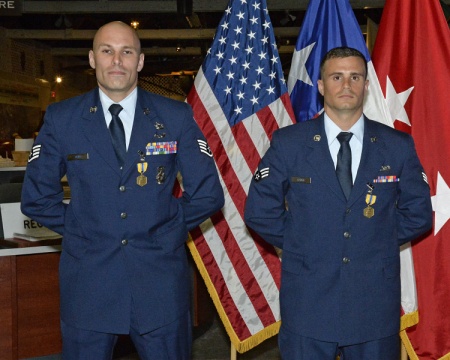Story By: 1st Lt. Alicia Lacy
Posted on: May 19, 2016
 Staff Sgt. Steven Hein, secruity forces airman 136th Airlift Wing, Senior Airmen Austin Kirwin, tactical air control party member, 147th Reconnaissance Wing, stand together after Hein and Kirwin are named the top junior enlisted and noncommissioned officer competitors at the Texas Army National Guard's Best Warrior Competition banquet May 13, 2016, at Camp Mabry in Austin, Texas. The annual competition is an Army-wide competition that tests the physical and mentual endurance of soldiers. (Air National Guard photo by 1st Lt. Alicia M. Lacy/Released)
Staff Sgt. Steven Hein, secruity forces airman 136th Airlift Wing, Senior Airmen Austin Kirwin, tactical air control party member, 147th Reconnaissance Wing, stand together after Hein and Kirwin are named the top junior enlisted and noncommissioned officer competitors at the Texas Army National Guard's Best Warrior Competition banquet May 13, 2016, at Camp Mabry in Austin, Texas. The annual competition is an Army-wide competition that tests the physical and mentual endurance of soldiers. (Air National Guard photo by 1st Lt. Alicia M. Lacy/Released)
AUSTIN, Texas -- The anticipation grew as the four airmen and soldiers stood at parade rest in front of a room filled with their peers, family members and leaders at the annual Best Warrior Competition banquet May 13, 2016, at Camp Mabry in Austin.
After the third drum roll and a few long pauses, the state’s Senior Enlisted Advisor Command Sgt. Maj. Mark Weedon announced this year’s top finishers for the Texas Military Department’s Best Warrior Competition. Senior Airman Austin Kirwin and Air Force Staff Sgt. Steven Hein earned the title best warrior and bragging rights for the next year.
“It’s an honor for our airmen to be recognized in the joint environment,” said Lt. Col. Timothy Pertuis, commander of the 147th Air Support Operations Squadron, 147th Reconnaissance Wing, Texas Air National Guard.
The Best Warrior Competition is traditionally an Army competition that tests soldiers’ physical and mental aptitude, but in 2013, the Texas Army National Guard integrated its Texas Air Guard counterparts. Since then, the Air guardsmen have competed with their Army comrades every year.
Kirwin, a tactical air control party member from the 147th ASOS, and Staff Sgt. Steven Hein, a security forces airman from the 136th Security Forces Squadron, 136th Airlift Wing, competed with about 60 other Texas Air and Army National Guardsmen, as well as Army reservists from the 75th Training Command and members from the Chilean armed forces during the four-day competition Feb. 4-7, 2016, at Camp Swift in Bastrop.
“Airmen are competing and accomplishing alongside their Army National Guard and Chilean counterparts, and once again, airmen take the title of best warrior in the state of Texas” Pertuis said. “Senior Airman Kirwin and Staff Sergeant Hein are great examples of the tough professionals that our Texas Air National Guard recruits and develops.”
Though this year was Kirwin’s first time competing, this is Hein’s second time competing for the title.
“I figured I’d give it another try,” Hein said. “It was a good experience. It’s fun. You get to meet some new people, experience new things and learn some new stuff.”
“It’s pretty impressive to make it twice in a row because he’s competed against all the guys in his wing and beat them out a second time to get there,” said U.S. Army Master Sgt. Shane Ruppel, BWC noncommissioned officer in charge, about Hein’s second appearance at the annual competition.
The competition tests competitors through a series of events, including urban warfare simulations, board interviews, marksmanship, land navigation, physical fitness tests, a road march, an essay, an obstacle course, and other warrior tasks and battle drills.
“The state of Texas leads the way in joint and international integration with our SPP programs and through the Best Warrior Competition,” Pertuis said. “I’m grateful for the opportunity to serve with and lead these great airmen.”